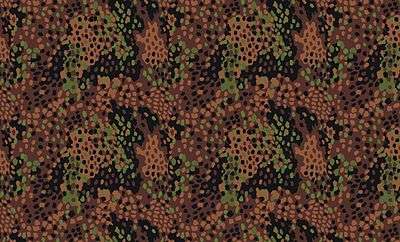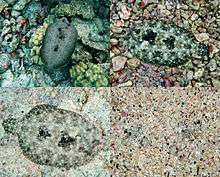Digital camouflage
.jpg)

Digital camouflage is a type of camouflage pattern combining micro- and macro patterns, often (though not necessarily) with a pixellated look created with computer assistance. The function is to provide military camouflage over a range of distances, or equivalently over a range of scales, in the manner of fractals. Not all multiscale patterns are pixellated, and not all pixellated patterns work at different scales, so being pixelated does not of itself guarantee improved performance.
The root of the modern digital camouflage patterns can be traced back to 1930s experiments in Europe for the German and Soviet armies. Modern digital patterns date to the 1970s with work by U.S. Army officer Timothy O'Neill for armor camouflage, later followed by Canadian development of CADPAT and then with US work led by O'Neill which created MARPAT.
Principles
Digital camouflage is based on three principles:
- Bi- or multi scale patterns – adding high spatial frequency texture components for concealment at closer ranges
- Dithering – producing intermediate colours where two fields of colour meet
- Edge effect – modifying visual processing of edges
Multi-scale patterns

The idea of a multi-scale pattern extends back to the interwar period in Europe. Early printed patterns of camouflage, like the 1929 Italian telo mimetico has larger and smaller elements in the patterns, but it was not until German experiments during the Second World War that true complex multi-scale patterns were developed. Traditional single scale patterns work well in their optimal range from the observer, however an observer too close or too far away will not see the pattern optimally. Nature itself is very often fractal, where plants and rock formations exhibit similar patterns across several magnitudes of scale. The idea behind multi scale patterns is both to mimic the cross-scale self-similarity of nature, and also to offer camouflage at close-range in addition to the traditional combat range camouflage.[1]
History
European experiments

The scale of camouflage patterns has an obvious effect on their use. Large structures need larger patterns than smaller vehicles and single soldiers to disrupt their shape. At the same time, large patterns are more effective from afar, while small scale patterns work better up close.[2]
During the Second World War, Johann Georg Otto Schick[lower-alpha 1] designed a series of patterns such as Platanenmuster (plane tree) and erbsenmuster (pea pattern) for the Waffen-SS, combining micro- and macro-patterns in one scheme.[3][4] The German Army developed the idea further in the 1970s into Flecktarn, which combines smaller shapes with dithering; this softens the edges of the large scale pattern, making the underlying objects harder to discern.[5]
Pixel-like shapes pre-date computer aided design by many years, already being used in Soviet Union experiments with camouflage patterns, such as "TTsMKK"[lower-alpha 2] developed in 1944 or 1945. The pattern uses areas of olive green, sand, and black running together in broken patches at a range of scales.[6]
Tank camouflage in the 1970s
In the 1970s, US Army officer Timothy R. O'Neill suggested that patterns consisting of square blocks of colour would provide camouflage that was more effective than traditional patches of brown and green.[7] Large patches of colour worked well at long range, and small patches at short range, but neither scheme worked well at all ranges. O'Neill's idea was to create a complex pattern of small (2 inch) squares, in modern terms pixels, so that at short range an observer would see a woodland pattern, while at long range the small pixels would merge into larger patches, giving the appearance of a woodland pattern at a larger scale also.[8]
The CADPAT and MARPAT
By 2000, O'Neill's idea was combined with patterns like the German Flecktarn to create pixellated patterns for battledress like the Canadian Forces' CADPAT and then the US Marines' MARPAT. The CADPAT and MARPAT patterns were somewhat self-similar (in the manner of fractals and patterns in nature such as vegetation), being designed to work at two different scales; a genuinely fractal pattern would be statistically similar at all scales.[9] A target camouflaged with MARPAT takes about 2.5 times longer to detect than older NATO camouflage which worked at only one scale, while recognition, which begins after detection, took 20 percent longer than with older camouflage.[8][9] Fractal-like patterns work because the human visual system efficiently discriminates images which have different fractal dimension or other second-order statistics like Fourier spatial amplitude spectra; objects simply appear to 'pop out' from the background.[9] O'Neill helped the Marine Corps to develop first a digital pattern for vehicles, then fabric for uniforms, which had two colour schemes, one designed for woodland, one for desert.[10]
Digital patterns for uniforms

The "digital" refers to the coordinates of the pattern, which are digitally defined.[11] The term is also used of computer generated patterns like the non-pixellated Multicam and the Italian fractal Vegetato pattern.[12]
According to the patent for MARPAT, pixellation does not in itself contribute to the camouflaging effect. The pixellated style, however, simplifies design and eases printing on fabric, compared to traditional patterns. While digital patterns are becoming widespread, critics maintain that the pixellated look is a question of fashion rather than function.[7][13]
"Digitizing" a pattern does not of itself improve performance; the design process involves trading-off different factors, including colour, contrast and overall disruptive effect. A failure to consider all elements of pattern design tends to result in poor results. The US Army's Universal Camouflage Pattern (UCP), for example, performed poorly because of low pattern contrast ("isoluminance"—beyond very close range, the design looks like a field of solid light grey, failing to disrupt an object's outlines) and arbitrary colour selection, neither of which could be saved by quantizing (digitizing) the pattern geometry.[8] According to the New York Times, O'Neill was "dismayed"[10] when the U.S. Army issued digital camouflage uniforms in only one colour range "to hide soldiers anywhere in the world, from sand dunes to jungles. 'I had 10 cat fits and a dog fit'"[10] as he considered that a single 'universal' scheme would be "useless everywhere".[10] In 2014 the U.S. Army tested new patterns to replace the single UCP for the same uniform, including woodland, semi-woodland and arid variants.[14]
Notes
References
- ↑ Vergun, David. "Army testing combat boots, camouflage patterns". United States Army. Retrieved 28 April 2014.
- ↑ Craemer, Guy. "Dual Texture - U.S. Army digital camouflage". United Dynamics Corp. Retrieved 27 September 2012.
- ↑ Peterson, D. (2001). Waffen-SS Camouflage Uniforms and Post-war Derivatives. Crowood. p. 64. ISBN 978-1-86126-474-9.
- ↑ "Schick, Johann Georg Otto (1882-)". Kalliope-Verbund. Retrieved 29 March 2016.
- ↑ Turner, B. "1938 amoeba pattern, green base". Kamouflage.net. Retrieved 28 September 2012.
- ↑ Turner, Brad (2004–2010). "1944/45 3-colour deceptive camouflage pattern (TTsMKK)". Kamouflage.net. Retrieved 24 January 2013.* Turner, B. "Bundeswehr Flecktarn, Federal Republic of Germany". Camouflage.net. Retrieved 28 September 2012.
- 1 2 Gye, H. (25 June 2012). "How U.S. Army spent $5BILLION on 'failed' pixel camouflage ... because they 'wanted to look cooler than Marines'". Daily Mail. Retrieved 21 November 2012.
'Brand identity trumped camouflage utility,' according to military journalist Eric Graves. 'That's what this really comes down to: we can't allow the Marine Corps to look more cool than the Army.'
- 1 2 3 4 O'Neill, Timothy R.; Matthews, M; Swiergosz, M. (2004). "Human Factors Issues in Combat Identification". Physical Review E. 60: 4637–4644. doi:10.1103/physreve.60.4637.
- 1 2 3 Billock, Vincent A; Cunningham, Douglas W.; Tsou, Brian H. Edited by Andrews, Dee H.; Herz, Robert P.; Wolf, Mark B. (2010). Human Factors Issues in Combat Identification. What Visual Discrimination of Fractal Textures Can Tell Us about Discrimination of Camouflaged Targets. Ashgate. pp. 99–101.
- 1 2 3 4 Kennedy, Pagan (10 May 2013). "Who Made That Digital Camouflage?". New York Times. Retrieved 18 April 2014.
- ↑ Craemer, Guy (2007). "CADPAT or MARPAT Camouflage". Who did it first; Canada or the US?. Hyperstealth. Retrieved February 3, 2012.
- ↑ Strikehold (2010). "Making Sense of Digital Camouflage". Strikehold. Retrieved 2 September 2012.
- ↑ Engber, D. (5 July 2012). "Lost in the Wilderness, the military's misadventures in pixellated camouflage". Slate. Retrieved 27 September 2012. Check date values in:
|year= / |date= mismatch(help) - ↑ Vergun, David (31 March 2014). "Army testing combat boots, camouflage patterns". U.S. Army. Retrieved 22 April 2014.
